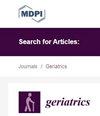Influence of Potentially Inappropriate Medication Use on Older Australians’ Admission to Emergency Department Short Stay
IF 2.1
Q3 GERIATRICS & GERONTOLOGY
引用次数: 0
Abstract
Older people in the emergency department (ED) often pose complex medical challenges, with a significant prevalence of polypharmacy and potentially inappropriate medicines (PIMs) in Australia. A retrospective analysis of 200 consecutive patients aged over 65 years admitted to the emergency short stay unit (ESSU) aimed to identify polypharmacy (five or more regular medications), assess PIM prevalence, and explore the link between pre-admission PIMs and ESSU admissions. STOPP/START version 2 criteria were used for the PIM assessment, with an expert panel categorizing associated risks. Polypharmacy was observed in 161 patients (80.5%), who were older (mean age 82 versus 76 years) and took more regular medications (median 9 versus 3). One hundred and eighty-five (92.5%) patients had at least one PIM, 81 patients (40.5%) had STOPP PIMs, and 177 patients (88.5%) had START omissions. Polypharmacy significantly correlated with STOPP PIM (OR 4.8; 95%CI: 1.90–12.1), and for each additional medication the adjusted odds of having a STOPP PIM increased by 1.20 (95%CI: 1.11–1.28). Nineteen admissions (9.5%) were attributed to one or more PIMs (total 21 PIMs). Of these PIMs, the expert panel rated eight (38%) as high risk, five (24%) as moderate risk, and eight (38%) as low risk for causing hospital admission. The most common PIMs were benzodiazepines, accounting for 14 cases (73.6%). Older ESSU-admitted patients commonly presented with polypharmacy and PIMs, potentially contributing to their admission.潜在用药不当对澳大利亚老年人入住急诊科短期住院的影响
在澳大利亚,急诊科(ED)中的老年人往往面临着复杂的医疗难题,多药和潜在不适当药物(PIMs)的发病率很高。我们对急诊科短期住院病人(ESSU)中连续收治的 200 名 65 岁以上患者进行了回顾性分析,旨在确定多重用药(五种或五种以上常规药物)情况、评估潜在用药不当的发生率,并探讨入院前潜在用药不当与急诊科短期住院病人之间的联系。PIM 评估采用 STOPP/START 第 2 版标准,由专家小组对相关风险进行分类。在161名患者(80.5%)中发现了多重用药现象,这些患者年龄较大(平均年龄为82岁对76岁),服用的常规药物较多(中位数为9种对3种)。185 名患者(92.5%)至少有一次 PIM,81 名患者(40.5%)有 STOPP PIM,177 名患者(88.5%)有 START 漏服。多药治疗与 STOPP PIM 明显相关(OR 4.8;95%CI:1.90-12.1),每增加一种药物,STOPP PIM 的调整几率就增加 1.20(95%CI:1.11-1.28)。有 19 例入院病例(9.5%)归因于一种或多种 PIM(共 21 种 PIM)。在这些 PIMs 中,专家组将其中 8 种(38%)评为高风险,5 种(24%)为中度风险,8 种(38%)为低风险。最常见的 PIMs 是苯二氮卓,占 14 例(73.6%)。ESSU入院的老年患者通常会同时服用多种药物和PIMs,这可能是导致他们入院的原因之一。
本文章由计算机程序翻译,如有差异,请以英文原文为准。
求助全文
约1分钟内获得全文
求助全文
来源期刊

Geriatrics
医学-老年医学
CiteScore
3.30
自引率
0.00%
发文量
115
审稿时长
20.03 days
期刊介绍:
• Geriatric biology
• Geriatric health services research
• Geriatric medicine research
• Geriatric neurology, stroke, cognition and oncology
• Geriatric surgery
• Geriatric physical functioning, physical health and activity
• Geriatric psychiatry and psychology
• Geriatric nutrition
• Geriatric epidemiology
• Geriatric rehabilitation
 求助内容:
求助内容: 应助结果提醒方式:
应助结果提醒方式:


